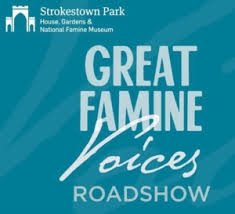Professor Timothy Meagher (Catholic University of America) on the Famine Irish in the United States and his own Famine Irish ancestry. Great Famine Voices Roadshow. Embassy of Ireland, Washington DC.
I have a special interest in the Famine because all of my great grandparents came either during it or just after it in the 1850s. They include my great grandfather Denis who came in 1858; my great grandfather Henry McDermott, my mother’s grandfather, who came in 1853…
We sometimes question whether the Famine was a significant event in Irish history or Irish-American history. Some historians think that maybe 1815 was a bigger moment in Irish history; and maybe one could argue that there are changes already going on in Irish-American history that are important before the Famine.
But I still think that the Famine is a major watershed in Irish-American history. I think that it is a watershed because it confirms changes that were just beginning.
One important one was the change in the regions from which people came from Ireland to the United States. The regional composition changed from a migration of people who had been largely in Ulster and Ulster borderlands people to a Munster and Connaught people, which is a very important change for all sorts of reasons: more Irish speakers, a much higher proportion of Catholics, and Catholics who had not lived among Protestants in their native counties much. They came from nationalist areas. Munster was an important area for Daniel O’Connell’s work: emancipation and repeal. So there are important changes in that respect.
There are important changes also in that the numbers of women, single women, who come grows. The trend had started before the Famine, but now it becomes confirmed, and that will become a real distinctive marker of Irish emigration in the United States and also Irish-American history. In fact, women in a lot of ways have had a major impact on the settlement patterns of Irish America. We often think of immigrants going to places where there is economic opportunity – but we think of men going to places where there is economic opportunity.
But in this case, it involves numbers of single Irish women, and the opportunities for women were in the east, in New England and the middle-Atlantic states and the big cities: such as domestic service, textile manufacturing, cloth and clothes making. So when you look at the numbers and proportions of women in those cities it is much higher than the proportions of men in the big cities like Boston, Philadelphia, and New York, and also some of the smaller New England and middle-Atlantic cities. So that is a big change, an important change, prefiguring an even bigger women’s migration later on in the century.
They get here. They are not always welcome. It is easy to get into the country at that point. The federal government does not control immigration at that point – does not administer immigration. The states do. The state of Massachusetts decided in 1837 that there were too many poor people coming in, too many poor Irish people coming into the state. They began to send people back to Ireland, or back to wherever they landed in the United States. So they began a deportation campaign that lasted for fifty years and sent fifty thousand people out of the state – most of them probably being Irish Catholics.
With that kind of hostility and a lack of skills, a lack of cultural knowledge of entrepreneurship, they didn’t do particularly well in the United States. Forty percent of Irish immigrant men were labourers in 1860.
But they were resilient. They were not hapless. They are often depicted as hapless, but they were not necessarily hapless. These processes of how people get here – most people depend on chains and networks, something that has come under some ill repute, that people would migrate in chains – but every immigrant group migrate in chains, and Irish people did as well.
And that is a good case of where my own history is a good exemplar. My great grand uncle Con, later Cornelius, was the first in his family to come to America from Ireland, from Tipperary. The family had lots its farm in the early 1850s. He went back in 1858 and brought his brother Denis who was my great grandfather here.
Same on the other side of my family, the McDermott family. My great grandfather Henry followed my great grand uncle James to America. It is a kind of everyday story in some ways it seems, but I think that it was important to them. It was remembered in family lore that when Henry was walking up the road in Auburn Massachusetts to find his brother, his brother was working on a barn roof and saw Henry from a long distance and began to shout and call out his name.
Now that is a kind of everyday circumstance. But when you think of people who have been separated by an ocean, their worlds transformed, that connection is remade in America – the importance of those immigrant links and connections.
